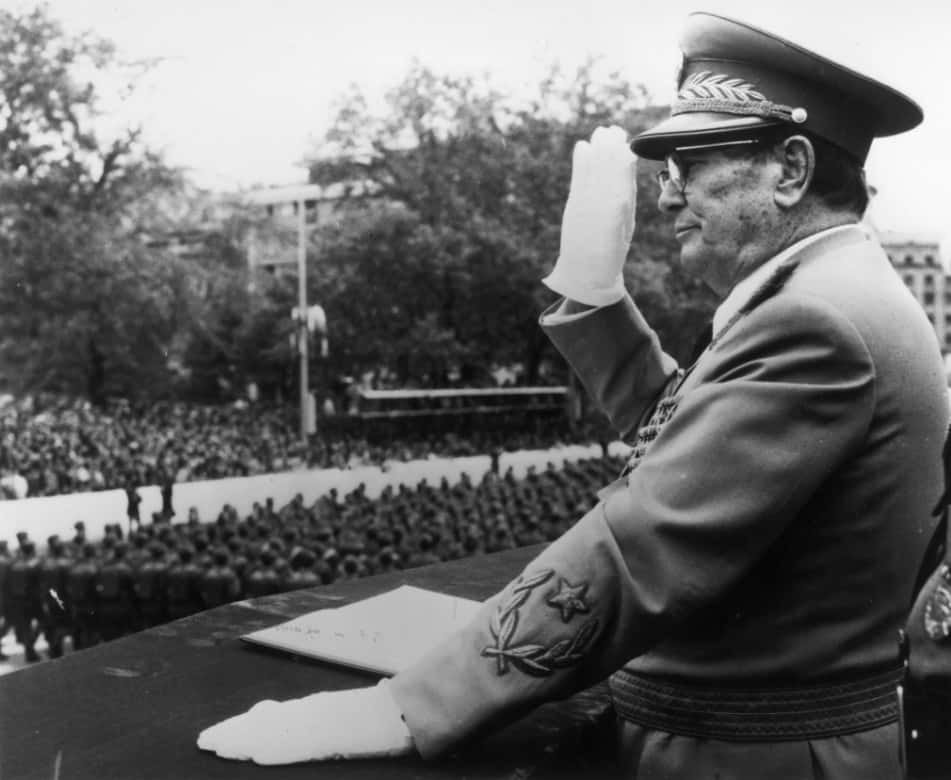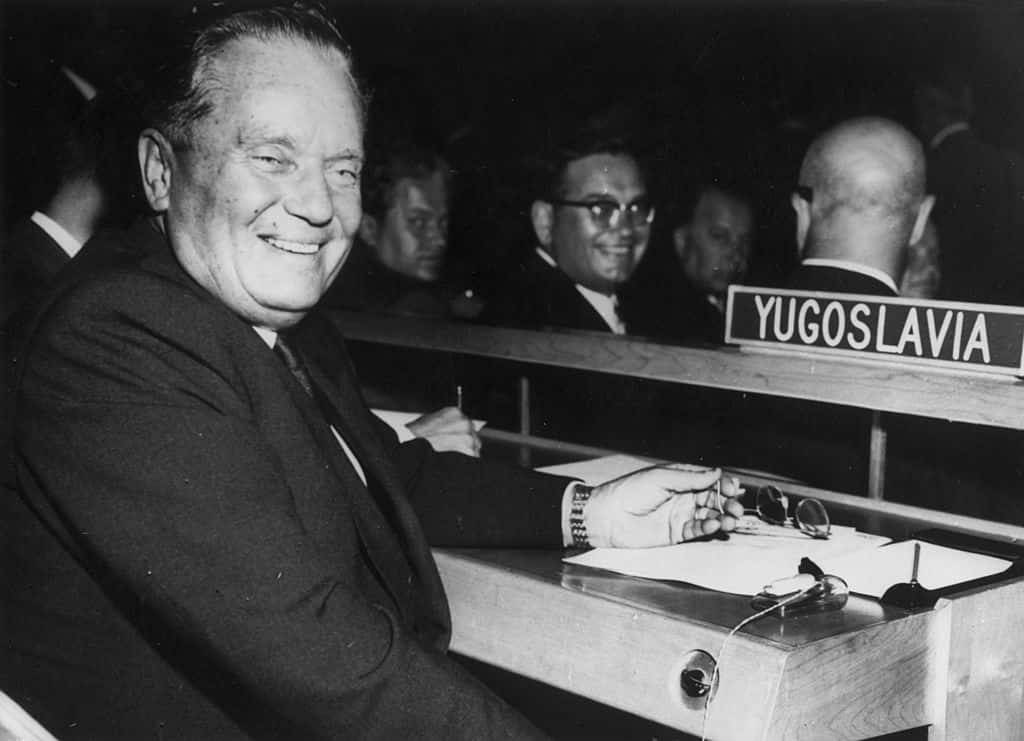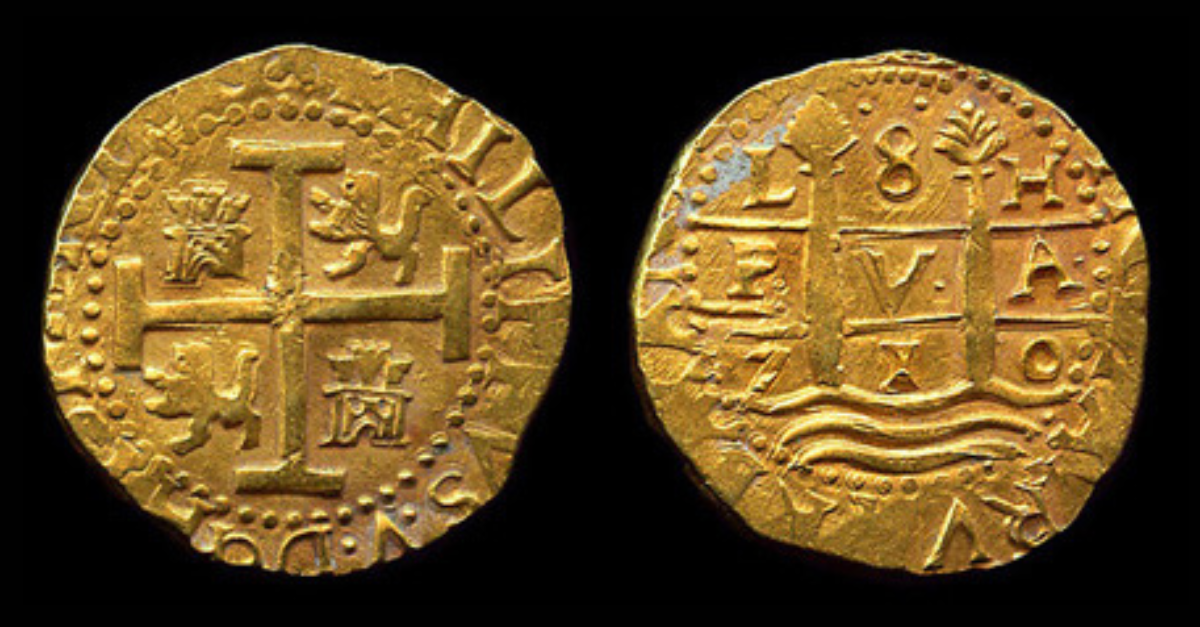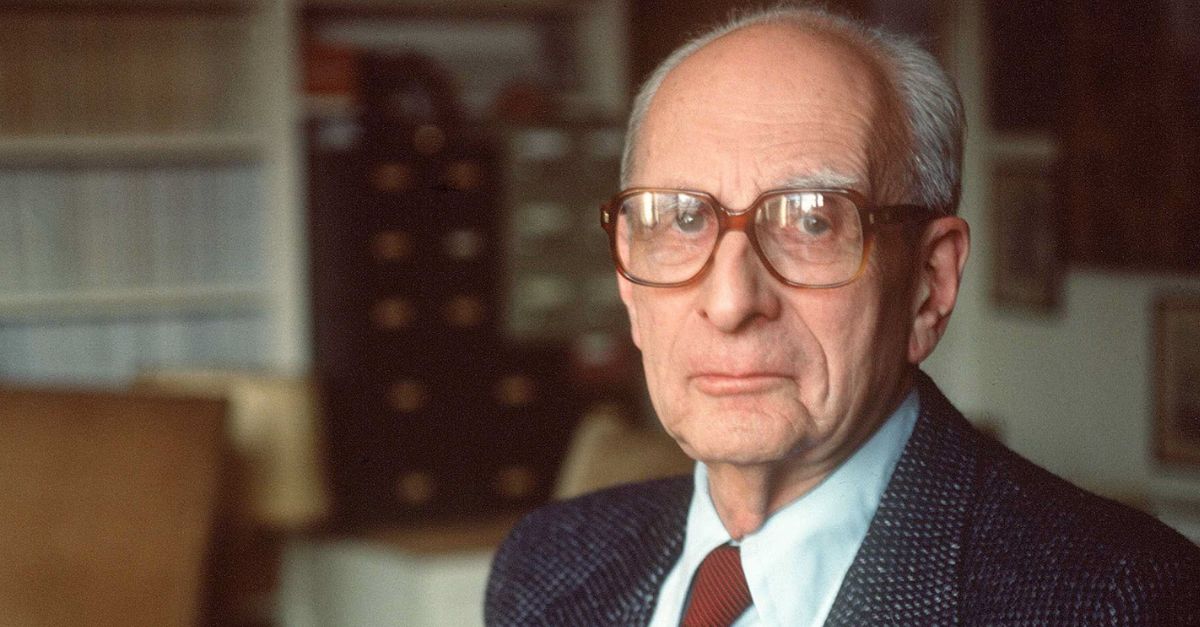The Eastern Bloc, coined as the Iron Curtain by the West, were the countries that formed a boundary between eastern and western Europe after WW2. Initially set up as a buffer zone to the Soviet Union, there was a great deal of tension between these countries, and with the West and the Soviet Union itself. Let's take a look at this powder keg.
41. Curtain Construction
The term "Iron Curtain" was originally used by German Chancellor Count Lutz Graf Schwerin von Krosigk towards the end of WWII, but it wasn’t until Winston Churchill adopted the phrase during a speech in 1946 that the term took root.

40. Memorial Erection
Churchill gave this speech at Westminster College in Fulton, Missouri, and after the Berlin Wall fell, a good portion of the wall was brought to the school and erected in memory.
39. Heavy Metal
The heaviest aircraft and the largest wingspan of any airplane in operation is the Antonov An-225 Mriya, designed and constructed in the Ukraine in the 1980s during the Soviet period. It holds the world record for heaviest airlifted payloads, and has now been repurposed from a space plane transportation vessel into a commercial flight plane.
38. Secular States
Religion was actively suppressed under the nations of the Eastern Bloc, and state atheism was enforced throughout. Churches and many of their followers were often targeted by the Soviets, and many landmarked religious buildings were demolished under orders from Stalin.
37. Eastern and Central
The countries of the Eastern Bloc were distinct from the rest of Europe, as they were all under the political influence of the Soviet Union. Even the countries of central Europe were regarded as eastern European countries during this time.
36. Rebellion(ish) Countries
Many of the countries of the Eastern Bloc were part of the United Soviet Socialist Republics. The exceptions were Albania, which was able to escape from Soviet control and align itself with China; and Yugoslavia, which was able to ward off Soviet control through the unified approach of its regional nations under the control of Josip Broz Tito and his army.
35. The Rest of The Pack
The other countries that made up the Eastern Bloc included East Germany, Poland, Hungary, Czechoslovakia, Bulgaria, and Romania.
34. Delayed Wall
The most famous symbol of the Eastern Bloc was the Berlin Wall, but it took some time for the wall to come into being. 15 years, actually, as the Soviet Union originally rejected the proposed idea of a wall. It took for the number of defectors to rise to 1,000 a day for Nikita Khrushchev to relent and approve construction. Once he did approve it, however, barbed wire barriers went up practically overnight, with concrete fortification to follow.
33. Democracy Rules
The first country to turn away from Soviet rule, denounce communism, and embrace democracy with an election in 1989 was Poland. The first president of the re-established country was Lech Walesa, originally an electrician turned union activist who was monumental in the fight for independence.
32. Peace Above All
Walesa was a co-founder of the Solidarity trade-union movement, which was outlawed by the Soviets during a period of martial law in Poland. Walesa was detained several times for his activist work, and in 1983 he won the Nobel Peace Prize. He was unable to accept the award, however, over the fear that his government wouldn’t allow him back into his home country afterward.
31. Bloc Heist
The most famous bank attack in the Eastern Bloc was carried out in 1959 by the Ioanid Gang, named after two brothers in the group, Alexandru and Paul Ioanid. The gang was comprised of six Jewish Romanians who were known as intellectuals and Communist Party members, and they were able to pull off the heist by holding up a National Bank of Romania van and emptying it of its contents while setting up “film in progress” signs to trick the public into thinking they were filming an action movie.  Shutterstock
Shutterstock
30. Propaganda Films
The Ioanid Gang take 1.6 million Lei—about $2 million today—but were caught after only two months. After a short trial, five of the six were sentenced to capital penalty, while one was given a life sentence due to her status as a mother. Before their execution, the Romanian government forced the perpetrators to reenact the heist for them on film, which they then released as propaganda in 1960.  Lê Minh, Pexels
Lê Minh, Pexels
29. Revolutionary Spring
One of the most inspiring moments in revolutionary history was the Prague Spring of 1968. While it was violently put down by the Soviet hegemony, it facilitated many of the revolutions to come and the ideas of liberal democracy across the region. International hockey legend Jaromir Jagr, who is still playing in the NHL at 45 years old, has worn the number 68 his entire career as a tribute to this moment of his home country.
28. Velvet Keys
Eventually, Czechoslovakia held its Velvet Revolution, also known as the Gentle Revolution, where the country overthrew the corrupt regime and restored democracy. During demonstrations, supporters began the practice of jingling their keys in the air as a symbolic gesture of support for unlocking the doors to democracy, and as a way of telling Communists “Goodbye, it’s time to go home".
27. Too Old to Fail
One exception to the rule that banned Eastern Germans from travelling to West Germany were retired pensioners. Since they were older, the government felt that they were less likely to completely uproot their lives and stay in the West, and if they did they, were too old to contribute to the other side's GDP.
26. Spy Team Stasi
The East German Stasi surveillance team was so large that they make other surveillance states looks tiny. With around 91,000 full-time employees, the Stasi outnumber the most famous of official states, the German Gestapo, who employed only 7,000 people.
25. CIA’s Guy
One of the most important CIA spies during the Cold Conflict was Colonel Ryszard Kuklinski, a ranking official in the Polish Army. Between 1972-1981, Kuklinski was able to gather thousands of pages of intelligence for the CIA, most of which was in regards to the army plans of the Soviet Union against Western Europe.
24. Canaries in the Bloc
The industry with the best pay and benefits during the time of the Iron Curtain was mining. However, while miners received the best accommodation and salaries, their working conditions were absolutely horrid, and the government propaganda spun the profession as comprised of “socialist heroes".
23. Dictator Complex
Romania’s Dictator Nicolae Ceausescu was uneducated, only going to elementary school until he was 11. As he rose to power, he became Europe’s youngest leader...and also its shortest, at only 5 feet 2 inches tall. Even Stalin towered over him at 5'4". As if his height didn’t create issues for him in his youth, he also had a speech impediment.
22. Inside Joke
Ceausescu was also once mocked by Salvador Dali for wielding a Royal Scepter. This very monarchical symbol runs counter to communism, and Dali sent him a letter making fun of him. Funny thing is, Ceausescu didn’t get the joke, and had the letter published in newspapers throughout Romania.
21. My Wife, the Scientist
Ceausescu also had his wife appointed the leader of the Romanian Chemistry research team. As one of the country’s most renowned scientists, she would travel Europe for science conferences. However, she was as uneducated as her husband, and didn’t have a clue about science, so when she would travel, it was her “translator” who was the actual scientist.
20. Fears Come True
Ceausescu lived his life with the fear of being shot. Well, that’s exactly how his life ended, as he was executed by firing squad after the Romanian Revolution in 1989. He was tried and convicted of sabotage and genocide during a speedy show trial.
19. Peaceful Revolutions
The Romanian Revolution may have ended in bloodshed, but it was the only one of the Revolutions of 1989 that turned violent. The rest of the revolutions throughout the Eastern Bloc were peaceful and considered a triumph for man.
18. Privilege in the East
The government elite of East Germany enjoyed many privileges, but perhaps none were more comfortable than Waldsiedlung, a housing zone built specifically for the leaders of the country. Though communism was supposed to rid society of classes, the East German elite created their own elite class for themselves. You know what they say, when you beat 'em, join 'em.
17. Most Wanted
The number one enemy of the state of East Germany was Wolfgang Welsch, a philosopher who had his freedom purchased by West Germany and subsequently began smuggling East Germans who wanted to escape into the West.
16. First Up
The first astronaut in space who was not either American or Soviet was Vladimir Remek of Czechoslovakia. He is also now considered the first European to reach space, as the Czech Republic eventually joined the European Union. However, it was largely due to the Soviets that he even reached space, and he has joked that his Soviet co-pilot would smack his hands from the controls if he attempted to do anything himself.
15. Defector
The army has always been a difficult place for gay officers. Jeff Carney was in the US Air Force during the Cold Conflict, and became dissatisfied with the US army's stance on the gay community. As a result, he defected across the wall and spent years spying for East Germany, helping them procure documents from the western world.
14. Payment by Steroid
Carney was paid quite modestly for his effort by East Germany, but money wasn’t the only way they rewarded him. Having accessed the top grade growth hormones, the government supplied him with high-quality steroids to help him with his hobby of long distance bicycle riding.
13. Only a Game?
General Josip Broz Tito of Yugoslavia was not someone people liked to disagree with. During downtime in the wars of national liberation, the army man would often organize sports matches to pass the time. During one particular match, the referee was having a rough time, and the game got out of control. In steps Tito to take over referee duties, saying, “Now let’s see whether some oppose the decisions of the referee?”
12. Don’t Mess With The Tito
Along the Eastern Bloc, it was common knowledge that Stalin would send in assassins to take out Soviet detractors. However, no one could really step in and do much about this—except Tito. After intercepting several assassins sent to end him, Tito wrote Stalin saying, “If you don’t stop sending killers, I’ll send one to Moscow, and I won’t have to send a second".
11. Justifying Actions
The Eastern Bloc justified their strict border control by claiming that if they did not maintain such tight authority, “brain drain” would occur and strip them of their intellectual human capital. The brain drain that did inevitably occur actually worked both for and against East Germany, in that while the drain damaged them economically and politically, it was responsible for removing many dissidents, effectively dissipating tension that led to violent revolts in other countries.
10. Pirate American Radio
The National Committee for a Free Europe, whose greatest legacy is Radio Free Europe, was created with the CIA to combat communism in Europe. From 1949 on, the United States government funded the broadcast, which pulsed out throughout the Eastern Bloc states as a Cold Conflict tactic. To this day, the station is still working in 23 countries, with a shifted focus to the Middle East.
9. Taken Defection
In 1983, seven Georgian citizens attempted to hijack Aeroflot Flight 6833 in an effort to defect from the Eastern Bloc. By posing as a wedding party, the group tried to divert the plane to Turkey, but the pilots were able to circle the aircraft around Tbilisi and land it. The hijacking went on for two days until the Soviet special forces unit Alpha Group was deployed, riddling the aircraft with 108 slug holes and ending three of the hijackers along with three crew members and two passengers.
8. Up, Up, and Away
One of the most famous ways people got through, or over, the Berlin wall was by hot air balloon. Hans Strelczyk and Gunter Wetzel built a makeshift hot air balloon for themselves and their families in 1979, and successful glided straight over the wall into the West.
7. Crossing Guards
Over the first two years of the construction of the Berlin Wall, over 1,300 border guards escaped East Germany by simply wandering or jumping over the wall, which in its early stages was nothing more than bundles of barbed wire. Talk about taking advantage of your authority.
6. The Play Boy Method
Whether he knew it or not, the late Hugh Hefner aided many East Germans across the border into the west. In Munich, there was a Play Boy Club, and it just so happened that the club’s membership card looked exactly like a diplomatic passport. Over the years, many border crossers took advantage of unsuspecting guards by flashing their play boy memberships, proving that sometimes all you need is a little creativity along with some luck...and the inspiration to see some skin.
5. Universal Jazz
For many in the Eastern Bloc, jazz was a window into the West and synonymous with American culture. It should be no surprise then, that the United States attempted to proliferate jazz programming throughout the Bloc with “The Jazz Hour” by Willis Conover. This program educated much of Europe and the Soviet nations about music, and it also inspired many Iron Curtain countries to create their own styles of jazz.
4. Where the Tech at
Throughout the Cold Conflict, the Western Bloc held an embargo, known as CoCom, on the Eastern Bloc, which restricted the East access to much of the technological and computing advances of the 20th century. This led to reverse engineering of western designs by eastern manufacturers, and to the widespread perception of the East’s technological backwardness.
3. Bringing Down the Wall
The beginning of the fall of the Berlin Wall was actually a premature mistake by politician Gunter Schabowski. At a press conference, he announced the lifting of travel restrictions a day before it was to be announced, which prompted people to rush to the wall, where the guards were unprepared for such a crowd. The rest is history.
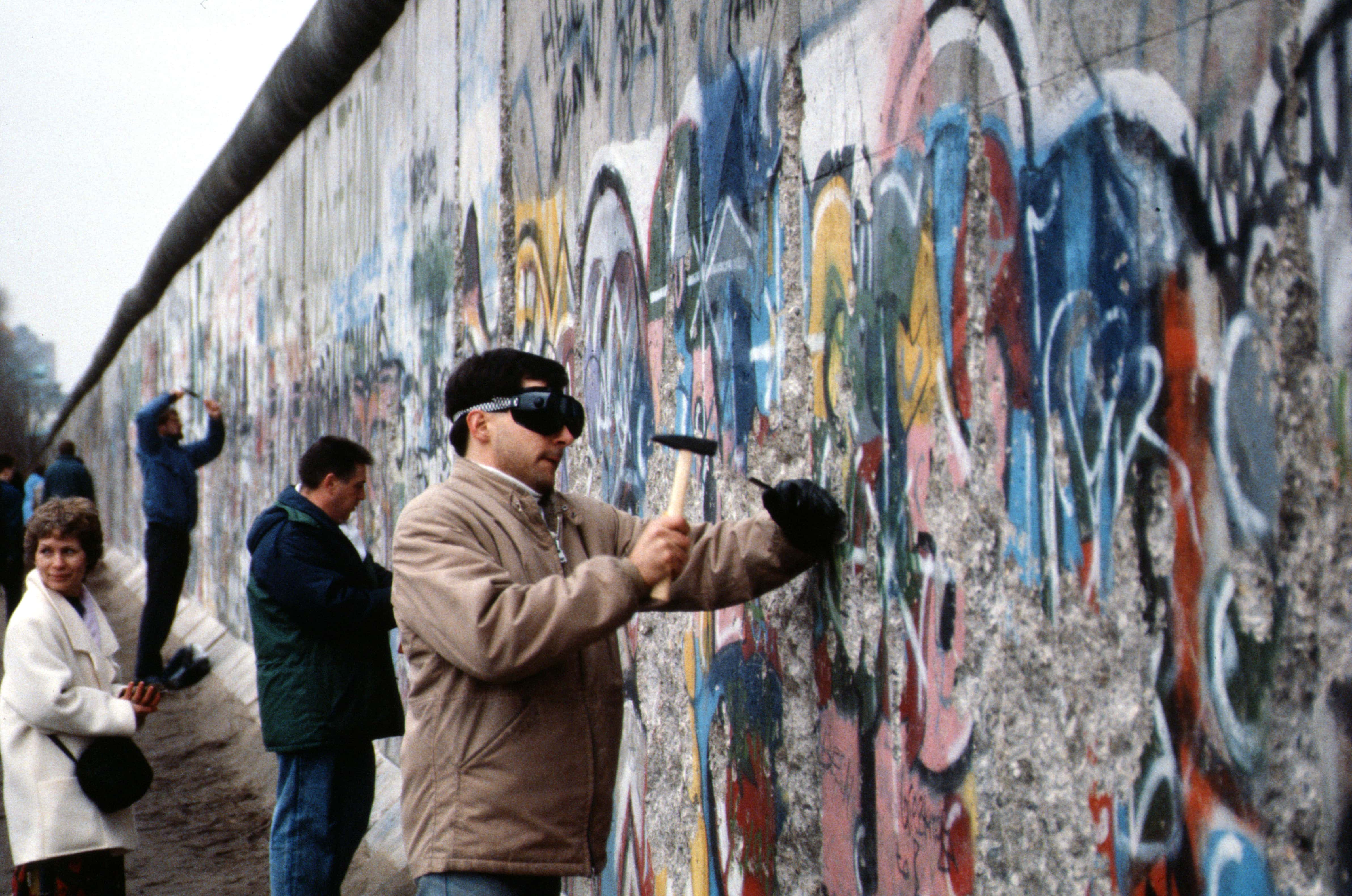 Wikimedia Commons, Raphaël Thiémard
Wikimedia Commons, Raphaël Thiémard
2. Urinal Pieces
A huge chunk of the Berlin Wall is on display in the men’s bathroom of a Las Vegas casino.
1. When It All Falls Down
The Soviets became known for top-secret, untraceable assassinations, but declassified CIA papers have finally revealed that the governments near the end of the Eastern Bloc were far from all powerful. These CIA intelligence reports, which document official Russian memoranda and transcripts, show the ways the USSR was scrambling for power during the dissident, rebellious period of the Revolutions of 1989. In one document, the Czechoslovak premier advises against violent responses to demonstrations because he is aware that this would incite further rebellion in a time when the government had little power or outside support; in short, the jig was up. Although the Iron Curtain was a fearsome place for a time, by the end, its central governments were crumbling.
Sources: 1, 2, 3, 4, 5, 6, 7, 8, 9, 10, 11, 12, 13, 14, 15, 16, 17, 18, 19, 20, 21, 22, 23, 24, 25, 26, 27, 28






